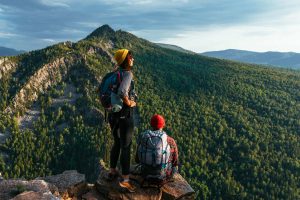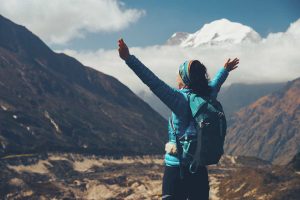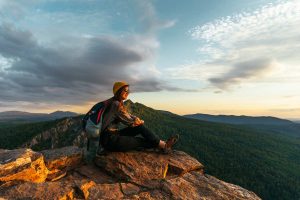Backpacking is an activity where people carry all of their supplies and equipment on their backs, allowing them to explore the outdoors with minimal impact. For a successful backpacking trip, it is essential to have the right equipment and gear in order to stay safe and comfortable during your journey. This article will provide an overview of the essential items you need for a backpacking trip.
The most important piece of equipment you’ll need are clothes that are suitable for outdoor activities such as hiking, camping, climbing, etc. It’s important to pack clothing that can keep you warm in colder climates but also breathable enough so that you don’t overheat when temperatures rise. Additionally, having multiple layers allows for better insulation against cold weather or rain showers. Other necessary gear includes backpacks, tents, sleeping bags and cooking supplies depending on how long your trip will be.
Navigation tools such as GPS devices or compasses are also helpful in keeping track of your route while communication options like cell phones can help if there’s an emergency situation. Finally, packing items like first aid kits flashlights and water filters should not be overlooked either since they play an important role in staying safe throughout the duration of your trip.
Bring The Right Clothes for Your Trip
When going on a backpacking trip, having the right clothing is essential for staying comfortable and safe. It’s important to pack items that can keep you warm in cooler climates as well as breathable enough so that you don’t overheat when temperatures rise. Additionally, having multiple layers allows for better insulation against cold weather or rain showers, so packing clothes such as long-sleeved shirts, pants and sweaters are recommended. The type of clothing you choose should be based on the climate of your destination and how long your trip will be.
Choose items that can keep you warm in cooler climates as well as breathable enough so that you don’t overheat when temperatures rise is essential. Long-sleeved shirts and pants are great for keeping the cold out while sweaters provide additional warmth. Wearing multiple layers allows for better insulation against cold weather or rain showers, making them ideal for colder conditions. Additionally, packing lightweight fabrics like nylon and polyester are recommended since they dry quickly and help to reduce pack weight.
Having the right clothes on a backpacking trip has numerous benefits including being able to regulate your temperature more easily, staying comfortable during long hikes, having protection from insects or allergens in the environment and preventing any potential accidents due to slippery surfaces or poor visibility caused by foggy conditions. Furthermore, wearing appropriate clothing helps to prevent blisters or other injuries which could put an end to your adventure sooner than expected.
Here is a short list of some of the most important pieces of clothing for backpacking:
- Hiking boots
- Waterproof jacket
- Long-sleeved shirt
- Quick-dry shorts or pants
- Hat/beanie
- Wool socks
- Gloves/mittens
- Underwear and bras
Warm Weather Backpacking
When backpacking in warm weather, it is important to bring clothing that can keep you cool and comfortable. This includes items such as lightweight shirts and shorts, hats or bandanas for sun protection, sandals or water shoes for wading through creeks or ponds and multiple layers of socks to protect against blisters.
Additionally, wearing sunglasses is essential for avoiding eye strain due to bright sunlight. Other important items include a sleeping bag rated for the temperature range of your destination as well as a tent designed to provide adequate ventilation when temperatures rise. Finally, packing electrolyte-rich snacks and plenty of water are also recommended since dehydration can occur quickly in hot conditions.
Cold Weather Backpacking
When backpacking in cold weather, it is important to bring clothing that can keep you warm and insulated. This includes items such as long-sleeved shirts and pants, sweaters, jackets or parkas, hats, gloves and multiple layers of socks. Additionally, wearing waterproof boots with good traction is essential for avoiding slips on icy surfaces.
Other important items include a sleeping bag rated for the temperature range of your destination as well as a tent designed to withstand windy conditions or snowfall if necessary. Finally, packing hand/toe warmers are also recommended when temperatures drop below freezing since they help to maintain body heat in extreme conditions.
Don’t Neglect the Essential Gear
Having the right gear is essential for a successful backpacking trip. From backpacks to tents, sleeping bags and cooking supplies, having the necessary equipment can make all the difference in staying safe and comfortable during your journey. This article will provide an overview of the essential items you need for a backpacking trip.
Choosing Your Backpack
Backpacks are an essential piece of gear for backpacking since they enable you to carry all your supplies and equipment with you. When selecting a backpack, it’s important to consider the size and weight capacity that best fits your needs as well as any additional features such as pockets or compartments for organizing items.
Additionally, look for packs with strong straps and good padding in order to avoid discomfort when carrying heavier loads. Finally, make sure the pack is waterproof or has a rain cover included so that your belongings remain dry during wet conditions.
It’s also a good idea to try on different backpacks in order to identify which one is most comfortable for you. Additionally, look for packs with strong straps and good padding in order to avoid discomfort when carrying heavier loads. Finally, make sure the pack is waterproof or has a rain cover included so that your belongings remain dry during wet conditions. Other features such as pockets or compartments can also be useful for organizing items more efficiently within your pack.
Consider these quick tips when choosing your first backpacking backpack:
- Capacity – When selecting a backpacking backpack, consider its capacity so that you can fit all your necessary gear inside without having to leave anything behind.
- Comfort – Make sure the pack is comfortable and adjustable in order to distribute weight evenly on your body while carrying it.
- Durability – Choose a backpack made from durable materials which can withstand wear and tear during long trips outdoors.
- Accessibility – Look for models with multiple compartments or pockets which provide easy access to items stored inside
Get a Good Tent
Tents are another essential piece of gear for backpacking since they provide a place to sleep and shelter from any bad weather. When selecting a tent, consider the size of the tent based on how many people will be sleeping in it as well as its weight capacity so that you know what kind of terrain it can handle.
Additionally, look for tents with waterproof materials such as nylon or polyester which also help to keep out insects or allergens in the environment. Finally, make sure your tent has multiple vents which promote air circulation and reduce condensation buildup inside.
Here are 4 important tips when selecting a backpacking tent:
- Size – When selecting a backpacking tent, consider its size and weight so that you don’t have worry about carrying too much weight during your trip.
- Ease of Setup – Make sure the tent is easy to setup in order to quickly create shelter in any situation.
- Waterproof Materials – Choose a tent made from waterproof materials which can help protect against moisture buildup during wet weather conditions.
- Ventilation System – Look for models with an effective ventilation system which can help keep air circulating throughout the interior space
Sleeping Bags Are Critical
Sleeping bags are an important piece of gear for backpacking since they provide warmth and comfort while you sleep. When selecting a sleeping bag, consider the temperature range of your destination as well as its weight capacity so that you know what kind of terrain it can handle.
Additionally, look for sleeping bags with synthetic insulation such as polyester or down which help to keep out cold air and retain body heat more efficiently. Finally, make sure your sleeping bag is waterproof in order to protect against moisture buildup inside if there’s any wet weather during your trip.
When selecting a sleeping bag for your backpacking trip, there are three important points to consider:
- Temperature range – Make sure you choose a sleeping bag rated for the temperature range of your destination in order to stay comfortable during colder nights.
- Weight capacity – Consider the weight capacity of your sleeping bag so that it can handle different types of terrain if needed.
- Materials – Look for lightweight materials such as nylon or polyester which allow for better air circulation and synthetic insulation like polyester or down which helps retain body heat more efficiently. Additionally, make sure the material is waterproof in order to protect against moisture buildup inside if there’s any wet weather during your trip.
Cold Weather Sleeping Bags
When backpacking in cold weather, it is important to use a sleeping bag with synthetic insulation such as polyester or down since they help to keep out cold air and retain body heat more efficiently. Additionally, using a waterproof material such as nylon or polyester can help protect against moisture buildup inside if there’s any wet weather during your trip. Finally, make sure your sleeping bag has multiple vents which promote air circulation and reduce condensation buildup inside for added comfort.
Warm Weather Sleeping Bags
When backpacking in warm weather, it is important to use a sleeping bag with lightweight materials such as nylon or polyester since they allow for better air circulation and reduce condensation buildup inside. Additionally, using synthetic insulation such as polyester or down can help provide additional warmth if needed. Finally, make sure your sleeping bag is waterproof in order to protect against moisture buildup inside if there’s any wet weather during your trip.
You’ll Need Cooking Supplies
Cooking supplies are an important piece of gear for backpacking since they provide a way to prepare meals without relying on pre-packaged snacks or eating out. When selecting cooking supplies, consider the types of food you plan on preparing as well as its weight capacity so that you know what kind of terrain it can handle. Additionally, look for items such as pots and pans made from lightweight materials like aluminum which are easier to carry but also durable enough for outdoor use. Finally, make sure your cooking supplies include utensils such as spoons or forks and a stove suitable for the conditions in order to cook any meals safely.
When choosing cooking supplies for your backpacking trip, there are a few points to consider:
- Types of food – Make sure you select items that can accommodate the types of meals you plan on preparing during your trip.
- Weight capacity – Consider the weight capacity so that it can handle different types of terrain if needed.
- Materials – Look for lightweight materials such as aluminum which are easier to carry but also durable enough for outdoor use.
- Utensils and stove – Make sure your cooking supplies include utensils such as spoons or forks and a stove suitable for the conditions in order to cook any meals safely.
Navigation Equipment Can Prevent Emergencies
Navigation equipment is essential for backpacking since it provides an accurate way to track your route and location. GPS devices, cell phones and compasses all provide helpful features such as the ability to store maps or navigate off-trail in order to find your way back if needed, long range capabilities which can help keep you connected even when there is poor reception in remote areas, luminous markings which can help keep you oriented even in low-light situations and waterproof materials which can help protect against moisture buildup during wet weather conditions. Having the right navigation equipment ensures that you stay safe throughout the duration of your trip.
GPS Devices
GPS devices are essential for backpacking since they provide an accurate way to track your route and location. When selecting a GPS device, consider its features such as the ability to store maps or navigate off-trail in order to find your way back if needed.
Additionally, look for models with long battery life as well as waterproof materials which can help protect against moisture buildup during wet weather. Finally, make sure the device has up-to-date software so that you have access to the most recent map data available.
When selecting a GPS device for your backpacking trip, there are few points to consider:
- Features – Make sure it has features such as the ability to store maps or navigate off-trail in order to find your way back if needed.
- Battery life – Look for models with long battery life so that you don’t have worry about running out of power while on the go.
- Waterproof material – Choose a device made from waterproof materials which can help protect against moisture buildup during wet weather conditions.
- Software – Ensure that the software is up-to-date so that you have up to date maps
Long Range Cell Phone
Cell phones are an important tool for backpacking since they provide a way to communicate in case of an emergency situation. When selecting a cell phone, consider its features such as battery life, waterproof materials and up-to-date software so that you have access to the most recent map data available.
Additionally, look for models with long range capabilities which can help keep you connected even when there is poor reception in remote areas.
Finally, make sure your cell phone has the necessary safety applications installed in order to stay safe during your journey.
Navigation Compass
Compasses are essential for backpacking since they provide a way to orient oneself in relation to geographical points. When selecting a compass, consider its features such as the ability to measure distances or mark locations on a map in order to stay on track.
Additionally, look for models with luminous markings which can help keep you oriented even in low-light situations such as early morning or evening hours.
Finally, make sure your compass is waterproof so that it can withstand any wet weather conditions during your trip.
When selecting a compass for your backpacking trip, there are few points to consider:
- Features – Make sure it has features such as the ability to measure distances or mark locations on a map in order to stay on track.
- Luminous markings – Look for models with luminous markings which can help keep you oriented even in low-light situations such as early morning or evening hours.
- Waterproof material – Choose a device made from waterproof materials which can help protect against moisture buildup during wet weather conditions.
- Accuracy – Ensure that the compass is accurate and reliable so that you have access up-to-date data available
Some Important Safety Equipment
Having the right supplies on a backpacking trip can make all the difference in staying safe and comfortable during your journey. From first aid kits to flashlights and water filters, having these items on hand is essential for any successful backpacking trip. This article will provide an overview of other important supplies you should bring along with you.
First Aid Kits
First aid kits are an important piece of gear for backpacking since they provide a way to treat minor injuries or illnesses while out in the wilderness. When selecting a first aid kit, consider its contents such as bandages, antiseptic wipes and pain relievers so that you have what you need if any medical emergencies arise.
Additionally, look for items with waterproof materials which can help protect against moisture buildup during wet weather conditions.
Finally, make sure your first aid kit includes medications such as antihistamines or asthma inhalers depending on any allergies or medical conditions you may have.
When selecting a first aid kit for your backpacking trip, there are few points to consider:
- Contents – Make sure it has all the necessary items such as bandages, antiseptic wipes and pain relievers so that you have what you need if any medical emergencies arise.
- Waterproof material – Choose a device made from waterproof materials which can help protect against moisture buildup during wet weather conditions.
- Medications – Consider packing medications such as antihistamines or asthma inhalers depending on any allergies or medical conditions you may have
Don’t Forget a Flashlight
Flashlights are an important tool for backpacking since they provide a way to illuminate dark areas or signal for help in case of an emergency. When selecting a flashlight, consider its features such as battery life and waterproof materials which can help protect against moisture buildup during wet weather conditions.
Additionally, look for models with adjustable brightness settings so that you can adjust the light output depending on the situation. Finally, make sure your flashlight has multiple modes such as strobe or SOS in order to signal for help if needed.
When selecting a flashlight for your backpacking trip, there are few points to consider:
- Features – Make sure it has features such as long battery life and waterproof materials which can help protect against moisture buildup during wet weather conditions.
- Brightness settings – Look for models with adjustable brightness settings so that you can adjust the light output depending on the situation.
- Modes – Ensure that the device has multiple modes such as strobe or SOS in order to signal for help if needed
A Water Filter Is Essential
Water filters are essential for backpacking since they provide a way to purify water from streams, rivers or other natural sources. When selecting a water filter, consider its features such as the ability to remove harmful bacteria and protozoa which can cause illness if consumed.
Additionally, look for models with long-lasting filters so that you don’t have worry about replacing them during your trip. Finally, make sure your water filter is lightweight and easy to use in order to quickly refill any containers you may have.
When selecting a water filter for your backpacking trip, there are few points to consider:
- Features – Make sure it has features such as the ability to remove harmful bacteria and protozoa which can cause illness if consumed.
- Long-lasting filters – Look for models with long-lasting filters so that you don’t have worry about replacing them during your trip.
- Weight/Ease of Use – Ensure that the device is lightweight and easy to use in order to quickly refill any containers you may have
It’s a Learning Experience
Backpacking is a great way to explore the outdoors and experience nature in its rawest form. However, it’s important to have the right equipment on hand so that you can stay safe and comfortable throughout your journey. From necessary clothing items such as waterproof jackets and pants, to essential gear like backpacks, tents and sleeping bags, having the right supplies will help ensure a successful adventure.
Additionally, navigation tools such as GPS devices, cell phones and compasses are essential for staying oriented while out in the wilderness.
Finally, other important supplies such as first aid kits, flashlights and water filters provide an extra layer of safety should any emergencies arise during your trip. Taking all of these things into consideration when packing for your next backpacking trip will help you enjoy every moment of your adventure!
Some Final Packing Advice
When it comes to backpacking, having the right supplies is essential. However, it’s also important to pack efficiently in order to lighten your load and make your journey as comfortable as possible. To do this, consider bringing multipurpose items such as a tarp which can be used both as a shelter or ground cover depending on the situation.
Additionally, look for lightweight versions of necessary items such as sleeping bags so that you don’t have worry about carrying too much weight during your trip.
Finally, make sure everything has its place in your backpack so that you can easily access what you need when needed. Following these tips will help ensure an efficient and enjoyable backpacking experience!
More Backpacking Posts
Tylor Bennett
An editor at Outdoors ReportTylor Bennett is a senior editor for the blogzine and also reports on breaking news based in London. He has written about government, criminal justice, and the role of money in politics since 2015.












